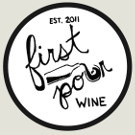The world of wine is constantly being broken into different groups by major characteristics. It can be White vs. Red, Sweet vs. Dry, Old World vs. New World, and the list will go on ad nausem. Still and Sparkling are two more such characteristics that haven’t been much discussed on First Pour Wine, but it’s time that we start.
After the pop:
- How’d it get so Sparkly?!
- Opening Sparkling
- Barefoot Bubbly Moscato Spumante
How’d the wine get so bubbly?
While the vast majority of wines are still, meaning, without carbonation, there are sparkling wines. These wines achieve the ability to sparkle via secondary fermentation, occurring in one of three ways.
- Carbonation occurs during a secondary fermentation in a large stainless steel tank.
- Carbonation occurs during a secondary fermentation in bottle. [methode champenoise]
- Carbonation is forced into the wine and stopped.
Secondary fermentation is critical in that the yeast eat added sugar in wine, and produce CO2, which has nowhere to go. This results in the small bubbles in the wine upon uncorking, and the need for such thick bottles and special corks. Generally, these methods produce different results.
- Methode Champenoise generally produces smaller bubbles, and preserves more of the delicate flavors.
- Secondary fermentation in large stainless steel tanks is cheaper than methode champenoise, but can lose some of the character of aging on the dead added yeast.
- Carbonation added to the wine manual is illegal in the European Union, but can be used in other places. The bubbles from this process can be larger, and doesn’t add any additional yeast.
How to Open Sparkling Wine
First and foremost, remember, Sparkling Wine bottles are thicker to contain the immense pressure of the wine (up to 6 atmospheres, think a truck tire, or 2 – 3 times the pressure of a car tire). That being said, do not point this bottle at anything that you do not mean to destroy. That being said, it’s not a weapon, but it could be.
- Remove the foil from the bottle.
- Place a hand over the cork, and remove the cage by turning the screw. [Yes, this means letting go briefly, to remove the cage, just get your hand back on as soon as possible.]
- Grabbing the cork, and the bottle, tilt slightly, and begin twisting in opposite directions extremely slowly pushing down with pressure.
- The cork should not make a loud popping sound! This process should be moving slowly, and making a sigh when released.
- Pour the champagne into a flute, and be mindful of the height.
This may take a few bottles to get down, but practicing can be a lot of fun with some friends to share the cost!
Barefoot Bubbly Moscato Spumante
Barefoot should take a lesson. No champagne on your bottle. Even if it’s made in the methode champenoise, if it’s outside of Champagne, France, it’s a no-go. Other than that Moscato Spumante it is indeed, with spumante, referring to completely carbonated, literally, foaming. While not an Italian, it might do an amazing Italian imitation, how does it do?
Sight: Golden straw and lightly fizzy.
Smell: Strong aromas of peach and apricot, plenty of lemon, and just a note of apple, tangerine, and nectarine.
Sip: A nice light mouth feel with small bubbles, and nice touch of sweetness immediately evident. It’s got a good crispness, like an apple, and flavors of apricot, nectarine, and peach. There’s a lemon pith in the background as well. [A.B.V. 10.5%]
Savor: There’s a great golden delicious apple and honey ending, with just a pop of peach.
Overall, it’s a fun enjoyable wine. The price is a bit high for a California entrant into the Moscato market, but in a pinch it’s a fun, fizzy variation. If you can’t find an actually Moscato d’Asti, give this ago, it won’t disappoint.
Verdict: Get out there and pop some strange bubbly
Price: $9.99
California
http://www.barefootwine.com/
